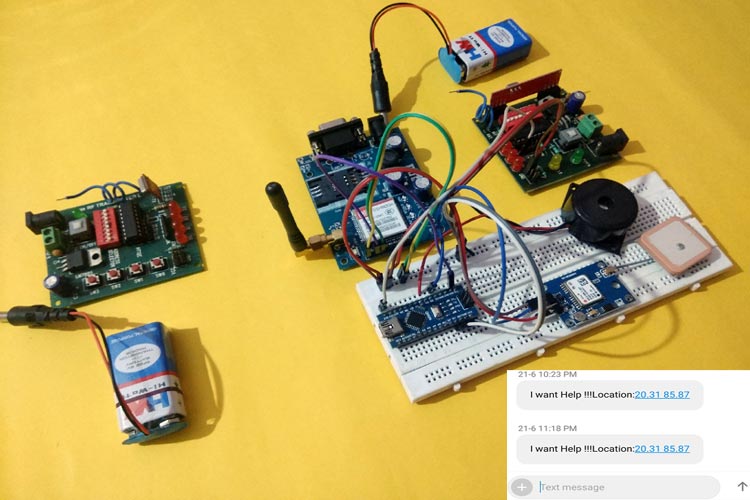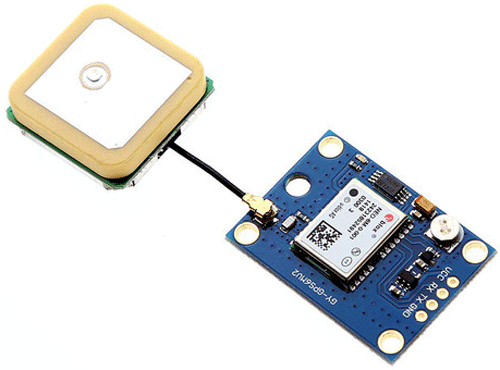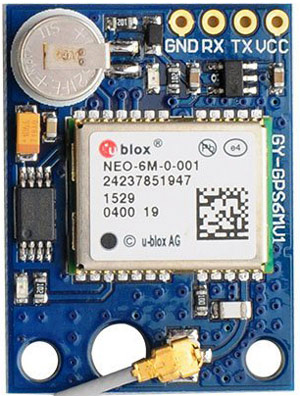
With all the technology available to us in recent times, it's not hard to build a safety device for women which will not only generate an emergency alarm but also send a message to your friends, family, or concerned person. Here we will build a band that can be worn by women, using which they can inform police or anyone, using SOS emergency SMS along with the current location. Using this information, the police will be able to save the victim from the location. For this, here we are using an Arduino which can be interfaced with GSM and GPS module for sending SMS alerts and getting the location coordinates. We have also used an RF Transmitter and receiver module for wireless communication between the Band and Receiving device with GPS/GSM.
Materials Used
- Arduino Nano
- SIM900 Modem
- NEO6M GPS module
- 433 MHZ RF Transmitter and Receiver
- Button
- Battery
- Breadboard
- Jumpers
GPS Module
Here we are using the NEO6M GPS module. The NEO-6M GPS module is a popular GPS receiver with a built-in ceramic antenna, which provides a strong satellite search capability. This receiver has the ability to sense locations and track up to 22 satellites and identifies locations anywhere in the world. With the on-board signal indicator, we can monitor the network status of the module. It has a data backup battery so that the module can save the data when the main power is shut down accidentally.

The core heart inside the GPS receiver module is the NEO-6M GPS chip from u-blox. It can track up to 22 satellites on 50 channels and have a very impressive sensitivity level which is -161 dBm. This 50-channel u-blox 6 positioning engine boasts a Time-To-First-Fix (TTFF) of under 1 second. This module supports the baud rate from 4800-230400 bps and has the default baud of 9600.
Features:
- Operating voltage: (2.7-3.6)V DC
- Operating Current: 67 mA
- Baud rate: 4800-230400 bps (9600 Default)
- Communication Protocol: NEMA
- Interface: UART
- External antenna and built-in EEPROM.
Pinout of GPS module:

- VCC: Input voltage pin of Module
- GND: Ground pin
- RX, TX: UART communication pins with Microcontroller
We have previously interfaced GPS with Arduino and build many projects using GPS modules including vehicle tracking.
GSM Module SIM900
This is a GSM/GPRS-compatible Quad-band cell phone, which works on a frequency of 850/900/1800/1900MHz and which can be used for various applications such as access the Internet, make a voice call, send and receive SMS, etc. The frequency bands of the GSM modem can be set by AT Commands. The baud rate is configurable from 1200-115200 through AT command. The GSM/GPRS Modem is having an internal TCP/IP stack which enables us to connect with the internet via GPRS. This is an SMT type module and designed with a very powerful single-chip processor integrating AMR926EJ-S core, which is very popular in various industrial products.
Technical Specifications:
- Supply voltage: 3.4V – 4.5V
- Power saving mode: Sleep Mode power consumption=.5mA
- Frequency bands: SIM900A Dual-band: EGSM900, DCS1800.
- Operating Temperature: -30ºC to +80ºC
- Supports MIC and Audio Input
- Speaker Input
- UART interface support
- Firmware upgrade by debug port
- Communication: AT Commands
We have previously interfaced GSM with Arduino and build many projects using the GSM module including the accident alert system.
Connection Diagram
Women Safety system with GPS Tracking & Alerts can be subdivided into two sections such as Transmitter and Receiver section. The circuit diagrams for each section is described as follows:
Transmitter Section:
In the RF Transmitter part, there will be an SOS button along with a 433 MHz RF transmitter, which will transmit the data to the receiver part wirelessly. The purpose of making two individual parts here is, to minimize the size of the transmitting module so that it can be worn as a wrist band. The circuit diagram for the transmitter part is shown below:
![]()
Receiver Section:
In the RF Receiver section, the data transmitted from the wrist band (Transmitter part) is received by the device having a 433 MHz RF receiver. The RF receiver sends this information to Arduino through the digital pin. Arduino Nano then receives the signal and processes it using the program which is flashed into it. When the victim presses the SOS button in the transmitter part, a HIGH signal is generated and passes to the Arduino side, and then Arduino sends a signal to SIM900 modem, to send an SMS to Registered user along with the GPS coordinate which has already been stored in the Microcontroller by the help of NEO6M GPS module. The circuit diagram of the Receiver side is shown as below:
![]()
Programming of Arduino
After successful completion of the Hardware connections, now it’s time for programming the Arduino Nano. The stepwise explanation of the code is given below.
Start the code by including all the required library files in the code like TinyGPS++.h for NEO6M GPS board, SoftwareSerial.h for defining the Software serial pins.
Here TinyGPS++.h library is used to get the GPS coordinates using the GPS receiver module. This library can be downloaded here.
#include <TinyGPS++.h> #include <SoftwareSerial.h>
Now, declare the connection pins of the GPS module and its default baud rate, which is 9600 in our case. Also, define the software serial pins using which GPS will communicate with Arduino.
static const int RXPin = 2, TXPin = 3; static const uint32_t gps_baudrate = 9600;
Then declare the objects for the TinyGPSPlus class. Also, define the object for SoftwareSerial class with the pins as arguments declared earlier.
TinyGPSPlus gps; SoftwareSerial soft(RXPin, TXPin);
Inside setup (), declare all the input pins and output pins. Then, initialize the hardware serial and Software serial functionality, providing the default baud rate which is 9600 in our case.
void setup()
{
pinMode(12,INPUT); // Input from RF module
pinMode(4, OUTPUT); // Output for Buzzer
Serial.begin(19200);
soft.begin(gps_baudrate);
}
Inside loop (), the digital input status for pin 12 is read and stored in a variable. When this status is HIGH, which indicates that, the switch is pressed in the transmitter side, hence the Arduino turns the Buzzer ON and also calls a function sendsms(), for sending the SMS regarding Location data.
void loop()
{
int key = digitalRead(12);
if(key==1)
{
digitalWrite(4,HIGH); // Switch ON the Buzzer
sendsms();
digitalWrite(4,LOW); // Switch OFF the Buzzer
}
else;
For receiving the GPS coordinates, the code is written which continuously checks for a serial terminal for incoming data from the GPS module. When valid data is found having GPS coordinates, this is stored in two separate variables as Latitude and Longitude.
while (soft.available() > 0)
{
gps.encode(soft.read());
if (gps.location.isUpdated())
{
Lat = gps.location.lat();
Lon = gps.location.lng();
}
else;
}
}
Finally, a function written is to send the SMS to the registered number. Here the SIM900 GSM modem is set to SMS text mode using AT + CMGF command. Then the recipient’s number is defined using the format shown. You can replace this with your mobile number. Then the message with location variables appended within is sent via the serial terminal.
void sendsms()
{
Serial.print("AT+CMGF=1\r");
delay(100);
Serial.println("AT+CMGS =\"+9194XXXXXXX\””);
delay(100);
Serial.println(“I want Help !!!Location:” + String(“Lat: “) +String(Lat) + “ “+String(“Lon: “) + String(Lon));
delay(100);
Serial.println((char)26);
delay(100);
Serial.println();
delay(5000);
}
Women Safety Device with GPS Tracking & Alerts Using Arduino
When the SOS button is pressed, the Buzzer starts beeping and an SMS will come to the authorized number containing the latitude and longitude of the location of the victim. The screenshot of the output is shown below:
![]()
Complete Arduino code and demo video are given below.
Complete Project Code
#include <LiquidCrystal.h>
#include <TinyGPS++.h>
#include <SoftwareSerial.h>
static const int RXPin = 2, TXPin = 3;
static const uint32_t gps_baudrate = 9600;
TinyGPSPlus gps;
SoftwareSerial soft(RXPin, TXPin);
String textMessage;
float Lat, Lon;
void setup()
{
soft.begin(gps_baudrate);
Serial.begin(19200);
pinMode(12,INPUT);
pinMode(4, OUTPUT);
}
void loop()
{
int key = digitalRead(12);
while (soft.available() > 0)
{
gps.encode(soft.read());
if (gps.location.isUpdated())
{
Lat = gps.location.lat();
Lon = gps.location.lng();
}
else;
}
if(key==1)
{
digitalWrite(4,HIGH);
sendsms();
digitalWrite(4,LOW);
}
}
void sendsms()
{
Serial.print("AT+CMGF=1\r");
delay(100);
Serial.println("AT+CMGS =\"+9194XXXXXX\"");
delay(100);
Serial.println("I want Help !!!Location:" + String("Lat: ") +String(Lat) + " "+String("Lon: ") + String(Lon));
delay(100);
Serial.println((char)26);
delay(100);
Serial.println();
delay(5000);
}Comments
Same issue here sir.. Can you
Same issue here sir.. Can you please tell me how to solve it
On which platform the circuit
On which platform the circuit simulation is done.... i am not getting the components in proteus.
You can use EasyEDA instead
You can use EasyEDA instead of proteus
Hello, why does the diagram
Hello, why does the diagram for the receiver section not have the GSM Module SIM900A?
Buzzer is beeping before
Buzzer is beeping before pressing the sos button and after pressing the button nothing happens. Pls sir slove this issue... Kindly requesting you to give me the solution for this problem
You can do one thing. just
You can do one thing. just take value k==0 instead of k==1. may be now it will start working. tell me issue has been resolved or not ?
Sir Pls solve this issue..
Sir Pls solve this issue.. Thanks you sir waiting for your reply.
TinyGPS++.h: No such file or
TinyGPS++.h: No such file or directory
I'm getting this error while copying code to aruino
Pls help
1.does the message goes to
1.does the message goes to the nearest police station or any selected phone number.
2.and is there any possibilty that the single reciver can be used to collect the longitude and lattitutude location?so that only one station can get the messages from vareious transmitters(women in danger).
TinyGPS++.h: No such file or…
TinyGPS++.h: No such file or directory
I'm getting this error while copying code to aruino please help me and which website that you complie the code and desidgn the circuit
TinyGPS++.h: No such file or…
TinyGPS++.h: No such file or directory
I'm getting this error while copying code to aruino please help me and which website that you complie the code and desidgn the circuit






buzzer is beeping before we give supply to gsm module and after complete connection when i press push button ..nothing is happening...can u please help me out!!!